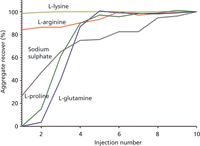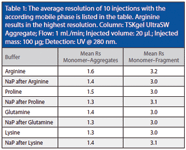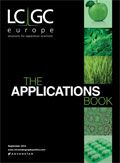A Toolbox of Amino Acids for Out-of-the-Box mAb Separations
The Application Notebook
Tosoh Bioscience
Size-exclusion chromatography (SEC) is well-established for mAb aggregate analysis. As the technique has been used since the early days of mAb development for pharmaceutical purposes, various method improvements have evolved. For instance, the benefits of arginine on analytical SEC of mAb aggregate samples are well-known. Here, we present how SEC of mAb aggregate samples can take advantage of other amino acid additives in the mobile phase.
Recently, various approaches to improve analytical SEC have focused on reducing the analysis time. For instance, this can be achieved by staggered injection protocols or increased linear flow rates — possible for columns with outstanding packing quality. On the other hand, in the light of method optimization, the mobile phase composition leaves less room for improvement when compared to other chromatographic modes. As soon as a certain ionic strength (important to inhibit electrostatic interactions without causing hydrophobic interactions) and the pH of the mobile phase (to ensure structural integrity of proteins and the stationary phase) are set, one might think that the analysis depends solely on the particle size, packing quality, and column length. However, the mobile phase composition is not complete until the mentioned parameters have been set. For example, Arakawa et al. have described the impact of arginine on aggregate recovery in SEC (1). Confirming that this effect was not caused by an increased ionic strength, Yumioka et al. investigated the impact of sodium chloride as a rather chaotropic salt on mAb aggregate SEC. By increasing the concentration of sodium chloride, protein recovery was decreased (2). In fact, the arginine addition ensured proper aggregate elution. This is also true for other amino acids, as can be seen in Figure 1.

Figure 1: Aggregate recovery in analytical SEC on new columns. The mobile phases contain different amino acids: Lysine (yellow), arginine (red), proline (green), and glutamine (blue). Sodium sulphate instead of an amino acid was added as a reference. Lysine and arginine allow almost complete aggregate recovery starting with injection #1, while proline and glutamine lead to reduced aggregate recovery compared to sodium sulphate. Column: TSKgel UltraSW Aggregate; Flow: 1 mL/min; Injected volume: 20 µL; Injected mass: 100 µg; Detection: UV @ 280 nm.
A mAb was aggregated by incubation at 75 °C for 5 min. The sample was subsequently analysed via TSKgel UltraSW Aggregate 7.8 mm × 30 cm/L with different mobile phases, all of them using virgin columns. A sample of 0.2 M lysine, arginine, proline, glutamine, or sodium sulphate was added to 0.1 M sodium phosphate buffer, pH 6.7, respectively. A flow rate of 1 mL/min was applied, and 20 µL and 100 µg of the aggregated mAb sample were injected. The columns were equilibrated for at least 10 column volumes. Figure 1 illustrates the results on aggregate recovery. Glutamine and proline show a similar behaviour: The aggregates are hardly recovered for the first two injections, while the aggregate peak suddenly appears for injection #3 and #4. The rise is not as sudden for sodium sulphate, but the aggregate peak only achieves its full size for injection #10. In contrast to these results, lysine shows an even and improved aggregate recovery compared to arginine. The inter-injection variability is low, depicting the complete aggregate content for all of the injections.

Figure 2: A mAb sample on TSKgel UltraSW Aggregate with 0.1 M sodium phosphate buffer containing 0.2 M arginine in the mobile phase (red). After 10 injections, the mobile phase was switched to sodium phosphate buffer with an addition of 0.2 M sodium sulphate (grey). For both mobile phases, injection #10 is shown. Column: TSKgel UltraSW Aggregate; Flow: 1 mL/min; Injected volume: 20 µL; Injected mass: 100 µg; Detection: UV @ 280 nm.
Besides aggregate recovery, resolution of the different sample components, namely the monomer and the different aggregates, is crucial for accurate analysis. Clearly, there is motivation to increase resolution. If this was achieved with a simple and inexpensive mobile phase additive, many applications could potentially benefit from such an advanced buffer composition. The impact of arginine in the mobile phase for analytical SEC of mAb aggregates focusing on the separation performance has been investigated and reported in the literature (3). Figures 2 and 3 depict the separation profile of an aggregated mAb sample on TSKgel UltraSW Aggregate using 0.1 M sodium phosphate buffer, pH 6.7, with an addition of either 0.2 M arginine or 0.2 M proline.

Figure 3: A mAb sample on TSKgel UltraSW Aggregate with 0.1 M sodium phosphate buffer containing 0.2 M proline in the mobile phase (blue). After 10 injections, the mobile phase was switched to sodium phosphate buffer with an addition of 0.2 M sodium sulphate (grey). Injection #10 of the corresponding mobile phase is presented in the chromatogram. Column: TSKgel UltraSW Aggregate; Flow: 1 mL/min; Injected volume: 20 µL; Injected mass: 100 µg; Detection: UV @ 280 nm.
Ten injections with the respective amino acid buffer were followed by 10 injections applying sodium phosphate buffer with an addition of 0.2 M sodium sulphate, to compare the two buffers. Monomer aggregate resolution as well as monomer fragment resolution is slightly improved for the two amino acid buffers. Table 1 lists the resolutions for some amino acid buffers and the results for the corresponding columns applying sodium phosphate buffer containing 0.2 M sodium sulphate. New columns were used for every amino acid.

Table 1: The average resolution of 10 injections with the according mobile phase is listed in the table. Arginine results in the highest resolution. Column: TSKgel UltraSW Aggregate; Flow: 1 mL/min; Injected volume: 20 µL; Injected mass: 100 µg; Detection: UV @ 280 nm.
Arginine, proline, and glutamine provide slightly increased monomer aggregate resolution. For arginine, the fragment monomer resolution is also improved. Although these increases in resolution are not drastic, they confirm that increased resolution as a result of the use of an advanced mobile phase is possible and that mobile phase testing can contribute to a more reliable and robust aggregate analysis. Depending on the attributes of a particular mAb, one might consider different amino acids. For mAbs which are especially prone to unspecific interactions, lysine might be the preferable option, as it provided the most reliable aggregate recovery beyond the tested amino acids in this study. On the other hand, if an aggregated mAb would cause less severe problems as a result of unspecific interactions, arginine offers highest resolution of all the tested amino acids and a slightly decreased aggregate recovery for the first injections, compared to lysine.
References
(1) T. Arakawa et al., J. Pharmaceutical Sciences 99 (4), 1674–1692 (2010).
(2) R. Yumioka et al., J. Pharmaceutical Sciences 99 (2), 618–620 (2010).
(3) D. Ejima et al., J. Chromatography A 1094 (1–2), 49–55 (2005).

Tosoh Bioscience GmbH
Zettachring 6, 70567 Stuttgart, Germany
Tel: +49 (0)711 13257 0 fax: +49 (0)711 13257 89
E-mail: info.tbg@tosoh.com
Website: www.tosohbioscience.de

Regulatory Deadlines and Supply Chain Challenges Take Center Stage in Nitrosamine Discussion
April 10th 2025During an LCGC International peer exchange, Aloka Srinivasan, Mayank Bhanti, and Amber Burch discussed the regulatory deadlines and supply chain challenges that come with nitrosamine analysis.



















